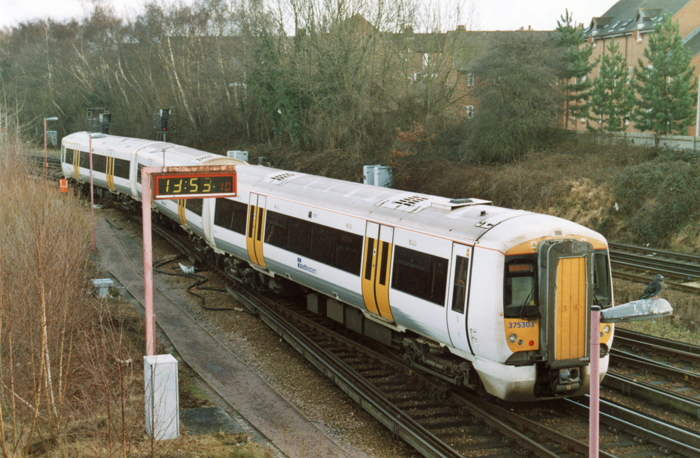
The first Class 375 for South Central operation arrived at Brighton on 11th March 2002 and was one of 28 three-car sets originally ordered by Connex. These units were designated 375/3 and unlike those of the South Eastern franchise, featured 2+3 seating in the centre car. In late 2003, the 375/3 fleet underwent a coupling change, which involved replacing the existing "Tightlock" coupling on the driving vehicles with an equivalent manufacturered by the Swedish firm "Dellner". That provided by Dellner was viewed as being a more reliable coupling than those originally supplied with the "Electrostar" fleet, posing less risk of breaking apart whilst the train was on the move and being more reliable in service in general. As a result, the 28 units were re-classified 377/3 and all subsequent Electrostar builds for the South Central franchise were also numbered under the 377 umbrella.
The Connex South Eastern franchise was terminated prematurely on 8th November 2003, as a result of financial mismanagement. Under the original terms of the contract, this was due to expire on 12th October 2011. An interim management team under the "South Eastern Trains" name, run by a public body called the "Strategic Rail Authority" (SRA), temporarily took over operations and oversaw the remainder of the Class 375 deliveries. The franchise was subsequently re-let to "Govia Group", which commenced operation in April 2006, and lessor Eversholt Rail was sold by HSBC to the "Eversholt Investment Group" in December 2010. The latter was sold on again in January 2015 to "CK investments S.a.r.l". Under the interim SRA operation, it was decided to retro-fit the South Eastern Class 375 batches with Dellner-manufactured couplings, as per the 28 three-car units which went to the South Central franchise. However, these units were not subsequently renumbered in the 377 series, remaining as Class 375.
In 2015, a mid-life refurbishment programme was started on the 112-strong Class 375 fleet, a joint venture between the "Southeastern Railway" franchise, manufacturer Bombardier, and lessor Eversholt Rail. Three-car No. 375301 was the first unit to be dispatched to Derby from Ramsgate on 11th April 2015, behind Class 57 No. 57306. It is scheduled to take 3½ years to complete the programme, each individual unit taking about three weeks to refurbish. Alterations include application of a new dark blue livery with light blue doors, more in line with the Class 395 "Javelin" fleet, and colour coding above the windows to indicate the locations of First Class and wheelchair accessible sections. New carpets and repainted grab rails are being fitted as part of the scheme, the toilet area re-vinyled, and the driver's cab refreshed. The seat moquette pattern will remain the same, but every seat is to be removed and dry-cleaned. "Southeastern" has reported that the refurbishment programme will consume 20,586 litres of paint, 16,334 square metres of carpet, and 6,400 square metres of lino. No. 375301 returned to Ramsgate in refurbished form, the first unit to be completed, on 16th May 2015.

Three-car No. 375303 is seen making its way out of "Jubilee Sidings" at Tonbridge West Yard. These are secure sidings, surrounded with palisade fencing, alongside the main freight yard. © David Glasspool

No. 375307 is seen stabled in the ''up'' side loop siding at Faversham. The two driving trailers of a three-car unit are powered, with the centre vehicle being a dummy. In four-car units, three of the vehicles are powered, leaving one of the centre coaches as a trailer. © David Glasspool

A line-up of Class 375 units is seen at Ramsgate; the station is just out of view, to the right. The pitched-roof building seen here was formerly the carriage cleaning shed for locomotive-hauled stock, before the ''juice'' was switched on in 1959. © David Glasspool
Return to the Kent Rail Homepage or alternatively, check for Updates.
Website & Copyright information - Links - Contact the Webmaster